Except as noted, article and photos by Joe Sapia.
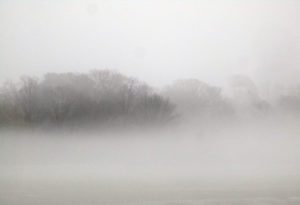
Rain and fog over “Jamesburg Lake” (Lake Manalapan) on the Jamesburg-Monroe boundary, Middlesex County, on the morning of February 11, Sunday.
HEAVY RAIN: The National Weather Service reported these preliminary rainfall totals in Jersey Midlands counties for the February 10-11, Saturday-Sunday, rainfall. The numbers are not necessarily a comprehensive listing, so there could have been higher and lower totals: Burlington — 1.55 inches at Chesterfield to 4.02 at west northwest of Tabernacle; Hunterdon — 1.00 at northwest of Milford to 1.81 at Wertsville; Mercer — 1.44 west of Princeton to 2.21 west of East Windsor; Middlesex — 1.74 at Sayreville to 2.28 at East Brunswick; Monmouth — 1.27 at North Middletown to 2.82 at Howell; Ocean — 1.23 at Island Heights to 3.19 at Barnegat Inlet; and Somerset — 1.12 at Martinsville to 2.19 at Middlebush.

Manalapan Brook Overflows Its Banks
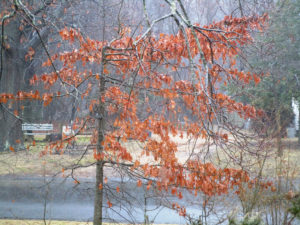
The leaves of an oak tree, genus “Quercus,” light up my front yard on a rainy day.
POOR DRAINAGE: A drainage issue flying under the radar is the clogging up of swamps — through filling them in purposely, by unintentionally clogging them by dumping leaves and other vegetative debris in them, and the overtaking of these wetlands by invasive species, such as phragmites reed grass. As the swamps clog and water is displaced, more flooding will happen.
In this Sunday, February 11, photograph of Helmetta Road, in the part of Monroe between Jamesburg and Helmetta, two problems are obvious: One, Helmetta Road (Middlesex County Route 615) passes through a low, swamp area and easily floods and, two, the surrounding swamps are clogged with phragmites. With phragmites, what is seen above ground is only an estimated one-fourth to one-third of the plant. Drive by wetlands and look at their changing nature — the overtaking by phragmites, easily identified by its tassel-like top.
Phragmites eradication projects are now underway or planned — for example, by Middlesex County Parks and Recreation at Helmetta Pond — but it is a complicated, labor-intensive, and costly undertaking. Combining that with the issue being ignored, by far not enough remediation is being done.
But something needs to be done, if not to protect the environment, then for practical anti-flooding reasons.
Look at this United States Geologic Survey website, https://nwis.waterdata.usgs.gov/nwis/peak…, for the highest flows per year on Manalapan Brook at the gauge on the Spotwsood-Monroe boundary. Over the last 60 years, four of the highest flows were in a recent 10-year period, from 2005 to 2014.
Keep covering up soil, keep filling in wetlands, and let these drainage issues get out of control. People will lose homes — think Tropical Storm Irene in 2011 and Superstorm Sandy in 2012, again in recent and back-to-back years — and be otherwise inconvenienced. Just wait….
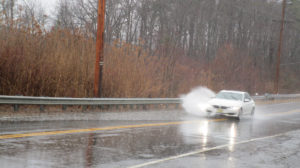
The combination of this section of Helmetta Road (Route 615) in Monroe, Middlesex County, passing through a swampy area and that area clogged with common reed grass, genus “Phragmites,” equals poor drainage.
SNOWFALL UPDATE: At Helmetta-Jamesburg-Monroe in Middlesex County, the snowfall on Saturday, February 17, was 3 inches, bringing the seasonal total to 21.5 inches. (The average seasonal snowfall at New Brunswick, Middlesex County, about 7.5 miles away, is about 26 inches. We still have about seven weeks left in the snowfall season.)
These figures for Saturday’s snow are from the National Weather Service. These are reported figures, not necessarily complete figures: Burlington County — 1.2 inches in the Eastampton and Tabernacle areas to 4.0 in Wrightstown; Hunterdon County — 4.3 in Wertsville to 9.3 in the Clinton area; Mercer County: 2.0 in the Lawrence area to 4.7 in the Hopewell area; Middlesex County — 2.0 in the Old Bridge area to 3.7 in the Cheesequake area; Monmouth County — 1.3 in Rumson to 3.0 in Colts Neck; Ocean County: .5 to 1.5, both in the Brick area; Somerset County — 3.3 to 7.4, both in the Bridgewater area; and in Pennsylvania’s adjoining Bucks County — 1.0 in Penndel to 6.4 in Springtown.
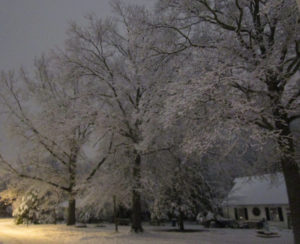
At night, as the Saturday, February 17, snow was ending, in my neighborhood in Monroe, Middlesex County.
SPRING PEEPER TREEFROGS: On the night of February 11, Sunday, I stepped outside my Monroe, Middlesex County, house and heard the nostalgic call of spring peeper treefrogs, “Pseudacris crucifer,” coming from the Manalapan Brook floodplain — kind of like sleigh bells. In February! But it was about 63 degrees on the night of a very rainy day. They are early maters — the calling likely either looking for mates or signaling territory. If you go looking for them, they will quiet as you approach and you likely will never find one. I recall seeing them only about 3 times in my 61 years. A check of my field notes going back to 1992, with only 2001 missing, shows this date as the earliest I had recorded for hearing them in a season. They likely will call and not call until we get consistently warmer weather. So, it will be interesting to see when they start calling strongly and consistently. I view peeper calls four ways: 1, these early calls; 2, regular calling; 3, late calling; and 4, an out-of-season aberration. As for their species name “crucifer,” they have a cross-like mark on their backs.

A spring peeper treefrog found in the Manalapan Brook floodplain of Monroe, Middlesex County, in 2017, March. In this photo, the X-like or cross-like mark on their upper to middle back is hard to see.
UPPER MILLSTONE RIVER EAGLE NEST: Anne Price, my fellow volunteer monitor of this nest on the boundary of Middlesex and Mercer counties, had a fabulous experience while watching the nest, where the bald eagles, “Haliaeetus leucocephalus,” are sitting on an egg or eggs. She watched a mature eagle flying with an immature. So, there is at least one immature in the immediate area of the nest. We expect the egg/s to hatch in late February or early March. We are not releasing the exact location of the nest to protect it because eagles, as breeders, are considered “endangered,” or in immediate peril, in New Jersey and, in general, are considered “threatened,” meaning if conditions deteriorate, they could become “endangered.”
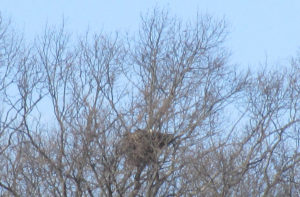
The head of a bald eagle pokes out of the Upper Millstone River nest. The eagles are sitting on an egg or eggs.
COASTAL PLAIN AND PIEDMONT: As I have noted previously, the Jersey Midlands is composed of two geologic regions: the rolling hills and rocky terrain of the Piedmont to the west and the generally flat land of the Coastal Plain to the east. (I also like to break up the Coastal Plain into the Inner and Outer.) For our purposes here, let us talk of the Piedmont with its soil of red shale and the Inner Coastal Plain with its gravelly soil. I was driving the other day in South Brunswick, Middlesex County, and noticed piles of dirt, basically displaying these two types of soil. In the following photograph, the red shale of the Piedmont is to the far left, the gravelly soil of the Inner Coastal Plain to the far right:
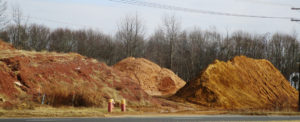
‘SPOTSWOOD LAKE’: On the flat-terrain Coastal Plain, there are few, if any, natural bodies of water. Instead, the water bodies are human-made, either by digging a depression or by damming a waterway. The approximately 60-acre “Spotswood Lake,” properly known as “DeVoe Lake” or “Mill Lake,” is an example — formed by the damming of Manalapan Brook shortly before it joins Matchaponix Brook on the Spotswood-Old Bridge boundary in Middlesex County to form the South River.
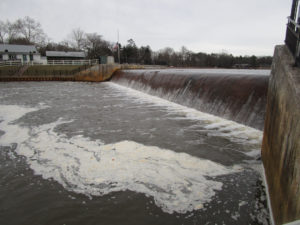
This dam holds back Manalapan Brook, forming Spotswood Lake.

This photograph of “Spotswood Lake” takes in a lot: wildlife (Canada geese, “Branta canadensis”), religion (a cross), patriotism (the American flag), and history (in the background, an old pump house to the right of the residential house).
BROKEN PITCH PINE: A branch on the pitch pine, “Pinus rigida,” in my backyard in Monroe, Middlesex County, was leaning. When I checked it, I saw that it was damaged. So, I chopped it off. I could put it out on the road, where the township picks up vegetative waste. Instead, I put it to use on-site, adding it to my backyard wildlife brush pile — often a haven for birds and presumably other wildlife. I try to keep my yard as a quarter-acre farm, discarding something in one place and using it elsewhere on the property.
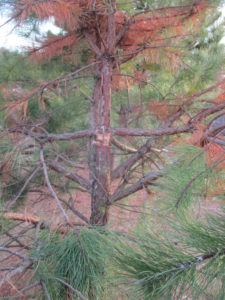
The broken branch area of the pitch pine.
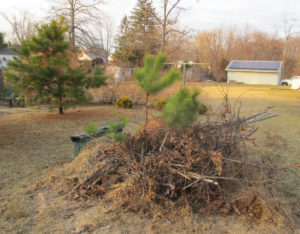
Notice the pitch pine in the background. It has a missing section. Well, there is the missing section, now in my wildlife brush pile in my backyard.
ATLANTIC OCEAN TEMPERATURES: The Atlantic Ocean temperature along the New Jersey coast was running at about 39 to 41 degrees on the February 17-18 weekend.
SUNRISE/SUNSET: From Sunday, February 18, to Saturday, February 24, the sun will rise about 6:40 to 6:45 a.m. and set 5:35 to 5:45 p.m. From Sunday, February 25, to Saturday, March 3, the sun will rise about 6:30 to 6:35 a.m. and set about 5:45 to 5:50 p.m.
FULL MOON: The next full moon is March 1, Thursday, the Full Lenten Moon.
WEATHER: The National Weather Service forecasting office serving the Jersey Midlands is at http://www.weather.gov/phi/.
MARJORY STONEMAN DOUGLAS: When I heard of the Wednesday, February 14, school shooting in Florida that took 17 lives, I thought of the school’s name: “Marjory Stoneman Douglas High School.” I hope Douglas’s name is not predominantly associated with the place where 17 murders took place; Douglas was an acclaimed environmentalist, author of the seminal 1947 “The Everglades: River of Grass.” Her name deserves better.
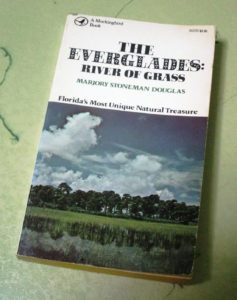
My copy of Marjory Stoneman Douglas’s classic book, “The Everglades: River of Grass.”
UPCOMING:
March 3, Saturday, 10 a.m. to 1:30 p.m., Somerset County — Deer Management Symposium at the Elks Lodge, 354 Route 518, Montgomery, free. Different stakeholders are to discuss deer management. More information is available at info@sourland.org.
March 10, Saturday, 11 a.m. to 12:30 p.m., Ocean County — Science Saturday, talk on striped bass management and fishing by Brendan Harrison, a New Jersey Division of Fish and Wildlife fishing technician,at the Long Beach Island Foundation of Arts and Sciences, 120 Long Beach Boulevard, Loveladies, 08008, $5 for non-members. More information at telephone 609-494-1241.
March 10, Saturday, 9 a.m. to 4 p.m., Atlantic County: 29th Annual Pinelands Short Course at Stockton University, 101 Vera King Farris Drive, Galloway, 08205. More information at https://stockton.edu/continuing-studies/conferences.html.
March 11, Sunday, 11 a.m. to 4 p.m., Atlantic County: 13th Annual Lines on the Pines, a Pine Barrens day of the written word, spoken word, art, and the performing arts at Stockton University, 101 Vera King Farris Drive, Galloway, 08205. More information at http://www.linesonthepines.org/linesonthepines.html.
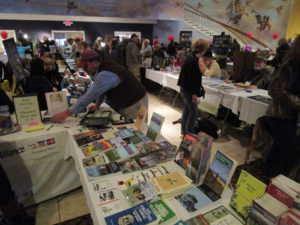
A scene from the 2016 Lines on the Pines event. This is a great event, one that I try to attend every year.
AS THIS FICKLE WEATHER WEEK ENDS: Sun, rain, and snow. Cold and warm temperatures. Soon, gardening and farming will be here. Until then….
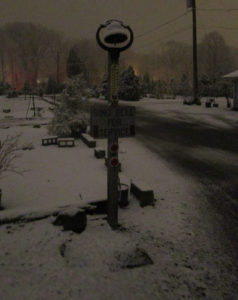
On this snowy night of Saturday, February 17, the bell will have to await its time to be rung at Krygier’s Nursery in South Brunswick, Middlesex County.
Joe Sapia, 61, is a lifelong resident of Monroe — in South Middlesex County, where his maternal family settled more than 100 years ago. He is a Pine Barrens naturalist and an organic gardener of vegetables and fruit, along with zinnias and roses.
He draws inspiration on the Pine Barrens around Helmetta from his mother, Sophie Onda Sapia, who lived her whole life in these Pines, and his Polish-immigrant grandmother, Annie Poznanski Onda.
He gardens the same backyard plot as did his Grandma Annie and Italian-American father, Joe Sr. Both are inspirations for his food gardening. Ma inspires his rose gardening.
Joe is a semi-retired print journalist of almost 40 years. His work also is at @JosephSapia on Twitter.com, along with Facebook.com on the Jersey Midlands page.
Copyright 2018 by Joseph Sapia
With grant support from the Middlesex County Office of Arts History, the Lower Raritan Watershed Partnership and coLAB Arts will implement the first component of the #lookfortheriver Public Art Program in New Brunswick’s Boyd Park in Summer 2018. The grant will allow for engineering and construction of a footing (the base) for a new public art piece for New Brunswick’s Boyd Park. The creative work to be installed at that site will serve both environmental/watershed awareness and cultural/community engagement purposes for the Raritan River waterfront at that site. Grant funding has been provided by the Middlesex County Board of Chosen Freeholders through a grant provided by New Jersey State Council on the Arts / Department of State.
The #lookfortheriver Public Art Program is a component of the LRWP’s #lookfortheriver watershed restoration campaign, which is designed to encourage community members to “look” for buried streams using landscape cues and historical research. #lookfortheriver is a package of actions communities can engage in around flood resilience and environmental restoration. The LRWP will be rolling out aspects of the #lookfortheriver campaign through 2018 and 2019.



Interview conducted by LRWP Raritan Scholars intern Quentin Zorn

Why did you decide to work with the LRWP?
In the past couple of years my work has been in community gardening, locally organized composting and food system development. I have focused my creative drives toward innovating and troubleshooting in these sectors via grassroots organizing and business startups.
The opportunity with coLAB and LRWP came along at the perfect time. I had just finished installing a geodesic greenhouse in an exhibition called LANDHOLDINGS at Index Art Center in Newark, NJ and was looking to invest more energy to art-making. Additionally LRWP’s mission incorporates scientific and geological considerations that at the time I was not familiar with: the focus on watershed heath and its intersection with the urban environment. I was eager to learn more.
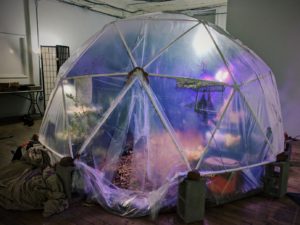
Processed with VSCO with g3 preset
How do you relate to the LRWP’s goals?
LRWP’s goals are to inspire environmental appreciation and stewardship, to inform relevant stakeholders on the watershed by building networks for sharing data about its health, and to innovate to improve watershed health responsibly with a diverse group of partners.
My role as a Resident Artist with the LRWP is to support their on-going projects and help generate new projects that align with these goals. Because my personal viewpoints also align with LRWP’s mission, my own integrity as an artist is not compromised. In fact, exposure to their programs and operations has been challenging and enlightening. The public needs organizations like LRWP to bring together science and community towards making impactful environmental efforts. Art plays a big role in this as it can help folks make the connection between the health of local environmental resources and one’s personal well-being in exciting and thought-provoking ways.
How does integrating art with science change the way you think about your own art?
Even the most traditional art forms require scientific understanding. For example, oil paint is an exceptionally difficult medium that if applied improperly can result in cracking and flaking once it sets. Research- historical, social, and technical- is always necessary for an artist and in-studio discoveries can be, in many ways, scientific in nature. I am used to shifting my medium to convey different kinds of ideas. As an interdisciplinary artist I am excited to collaborate and learn more technical languages.
How does the interpretive nature of art help or hinder conveying the messages you want people to understand?
This tension is one of my favorite parts of art making. The artist Patricia Piccinini is a huge inspiration of mine as much of her work is about the “creator’s” inability to control their “creation.” Experienced artists are able to walk the tight rope between intention and perception, directing the viewer but leaving enough space in the work open for the viewer to be able to identify and enter into it. Of course, not all art works intentionally speak to all audiences.
How do the sculptures from project WADES help achieve the LRWP’s goals or environmental goals in general?
Project WADES stands for Watershed, Action, Dialogue, Education and Stewardship and aims to develop Environmental Education curriculum. The sculptures are positioned at the intersection of WADES with a public sculpture project under a program called Rail Arts River, which aims to connect New Brunswick communities to the Raritan though art and green infrastructure. The sculptures from Project WADES are casts of the hands of youth clasping pieces of trash collected at clean ups along the streams of the Raritan Watershed. They serve to inspire increased connection between human behavior and watershed health within LRWP’s watershed curriculum.

When the sculptures are completed, what is the reaction you are hoping for?
To be honest I haven’t reflected on the reaction as much as the intention and the varying methods that coLAB, LRWP, and I have discussed for presentation! So far this work is still going through a collaborative gestation process. The sculptures will be brought back to the schools for semi-permanent art installations but will also be used in a larger public sculpture at Boyd Park. When the work is complete I am very much looking forward to seeing what people think.
How did you create the River Walk book and what do you hope people take away from it?
River Walk is a kind of functional art work, much more sentimental and straightforward then my typical work. It is a usable notebook made primarily from recycled materials: reused paper, cardboard, old art prints and wood binding. The wood binding was fabricated from materials gathered from a FEMA buy-out home that was deconstructed and transformed into a rain garden and flood storage park, an exciting project done by landscape architect and Rutgers Professor Tobiah Horton. The signature sheets include linocut prints of humans in nature. These images were taken directly from a hike with coLAB Arts on the D&R canal in New Brunswick. The only way to acquire this work is by donating to LRWP. My hope is simply that people enjoy it and use it!

What effect do you think the Windows of Understanding project has on the community or the local environment?
Windows of Understanding is a public art project set in multiple storefront businesses. It operates like a rhizome, utilizing the brain power of local advocates and artists to filter their mission and work through a prompt. This year that prompt is ”We See Through Hate.” I see so much mutual benefit here and I’m excited about the realistic, but hopeful message. Our country is going through rapid change that seems to hark on hard times for so many of us. Americans are under incredible pressure from the media, from the antagonistic government, from the precarious state of healthcare, and from a job market threated by automation. To be truly resilient, in an environment filled with risk, disparate communities should be given opportunities to know each other face to face; to move past bigotry and ignorance and to see through hate. Windows of Understanding will address these struggles, but provide hope and positivity to the surrounding public. I believe this effort will have a positive effect on the passerby, increase the visibility of advocate organizations, and increase community cohesion.
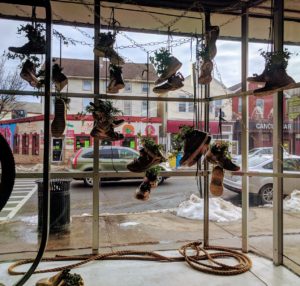
We applaud the following Lower Raritan Watershed towns for securing Sustainable Jersey status in 2017!
East Brunswick – bronze
Edison – bronze
Monroe – bronze
New Brunswick – bronze
Plainsboro – bronze
South Plainfield – bronze
Woodbridge – silver
Hillsborough – silver
Somerville Borough – bronze
Warren Township – silver
Berkeley Heights Township – bronze
Summit City – silver
Extra kudos to New Brunswick, Perth Amboy and Woodbridge for securing 20 points in the “Climate Adaptation: Flooding Risk” action. This action is designed to help communities: 1) identify their vulnerability to flooding impacts (both coastal and inland) and 2) identify ways to improve their overall resiliency. This action focuses on the various causes of flooding that could impact a community, either now or in the future, including increased precipitation, increased frequency of heavy precipitation events, sea level rise and storm surge.
Climate change, population growth, urbanization and industrialization are all putting pressure on our communities and their access to safe and secure water supplies. Sustainable Jersey now awards points for Green Infrastructure Planning and Implementation Actions that can directly improve the water quality of our rivers and streams. Read more about these water-friendly actions on the Sustainable Jersey website.
Except as noted, article and photos by Joe Sapia
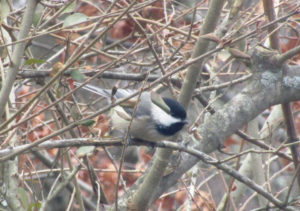
A Carolina chickadee in the front yard shrubbery of my house in Monroe, Middlesex County. Here, looking at the bird through the living room window.
BIRDING THROUGH THE WINDOW: One of my favorite places to watch birds is through my living room window. The love seat, my favorite resting spot, is across from the window, providing the lazy person’s way to birding. Birds perch in the shrubs and, if lucky enough, I take a good photo of them. Recents include the Carolina chickadee, “Poecile carolinensis“; cardinal, “Cardinalis cardinalis”; house sparrow, “Passer domesticus,”; and junco, or “snowbird,” or “Junco hyemalis.
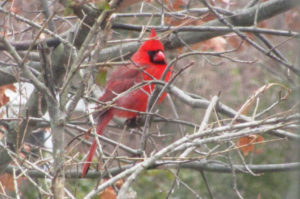
A cardinal outside my living room window, easily identifiable as a male because of its bright red color.
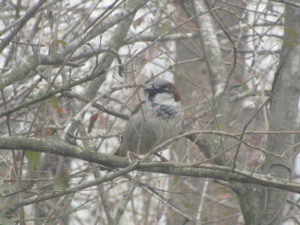
A house sparrow outside the living room window.

Another view of a house sparrow, showing off its colorful pattern.
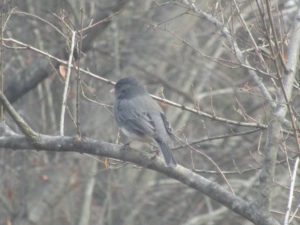
A junco, or “snowbird,” outside the window.
SNOWFALL: Flurries on Sunday, February 4, did not accumulate at my home in Monroe, Middlesex County. But on Wednesday, we had a dusting. So far, the season’s total is 18.5 inches (at my house). The normal seasonal total at New Brunswick, Middlesex County, about 7-1/2 miles away is about 26 inches. We still have about two months left of realistic snow weather.
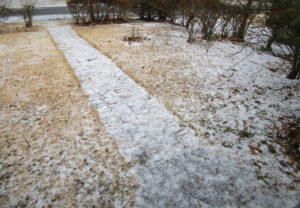
The dusting of snow Wednesday, February 7, in my front yard in Monroe, Middlesex County.
ALONG MANALAPAN BROOK: I live across the street from Manalapan Brook in the house I was “born” in — actually taken to this Monroe, Middlesex County, home from the hospital of my birth. I often escape to a few minutes of woods time by walking the few hundred feet to the Brook. This week, I shot photos there on the snowy Wednesday, February 7, and the rainy-foggy Saturday, February 10. Manalapan Brook’s headwaters are in the area between downtown Freehold, Monmouth County, and the Great Adventure amusement park in Jackson, Ocean County. From its headwaters to where it meets Matchaponix Brook and the two form the South River at Spotswood and Old Bridge in Middlesex County is a straight line of about 15 miles in a direction heading north. It drains 43 square miles in Middlesex and Monmouth counties. The Brook, its floodplain, and surrounding woods are no longer as mysterious and no longer as big (literally and in in my mind) as when I was a kid, but they still provide an adventure. My family has lived along Manalapan Brook since about 1900.
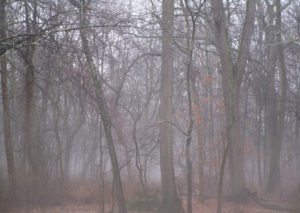
A foggy Saturday, February 10, in the swamp hardwood forest of the Manalapan Brook floodplain.
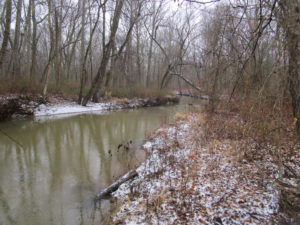
A dusting of snow along Manalapan Brook on Wednesday, February 7.
VOICES FROM AFIELD, RED-SHOULDERED HAWK: Mike Deitche of Monroe checked in with a great photograph of a red-shouldered hawk, “Buteo lineatus,” he took Tuesday, February 6, in Hamilton, Mercer County. “The hawk was on a path as I was walking,” Mike said. “It must have been finishing up its meal when I noticed it. I took three photos (of it) on the ground. Then, it flew up to the top of the tree. It was a lucky shot. I circled around, but it had taken off. I took some photos of the remnants of its meal — looked like breast feathers and tail feathers.”
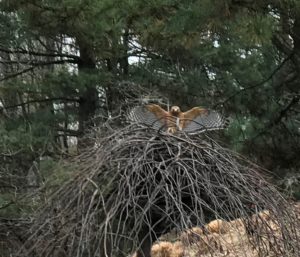
A red-shouldered hawk in Hamilton, Mercer County. “It’s one of our most distinctively marked common hawks, with barred reddish-peachy underparts and a strongly banded tail,” according to Cornell University’s All About Birds website. (Photograph copyright 2018 by Mike Deitche)
LIGHTED CANDLES IN THE WOODS: Pass a forest and you might see leaves of gold on small trees, “lighting” up the woods. These are beech trees, genus “Fagus.” Snow certainly paints a beautiful picture in a winter woods, but when there is no snow, look for these beeches to add some sparkle to the otherwise earthy tones.
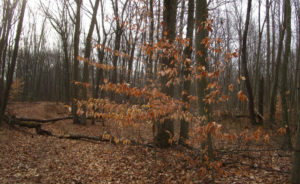
Beech trees “sparkle” at a hardwood forest at Pigeon Swamp in South Brunswick, Middlesex County.
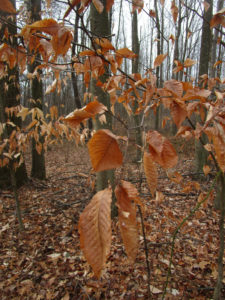
A closeup of a beech tree at Pigeon Swamp in South Brunswick, Middlesex County.
DEBBIE MANS, FROM BAYKEEPER TO DEP: Debbie Mans has watched over the New Jersey-New York Harbor Estuarty for 10 years as director of the New York-New Jersey Baykeeper group, based in Keyport, Monmouth County. Now, Debbie is moving on to be deputy commissioner of the New Jersey Department of Environmental Protection. Debbie is the type of person we need in government — smart, passionate but low key, a leader. As a Jersey boy who went to college in Wisconsin, I appreciate Debbie’s Upper Midwest sensibility — in her case, growing up in Michigan — and, as she put it, now “with a splash of New Jersey.” Congrats, Deb! (A profile I did on Debbie in 2016, September, http://tworivertimes.com/debbie-mans-midwesterner-with-jersey-sand-in-her-shoes/.)
IF YOU THINK YOU HEAR A WOMAN SCREAMING IN THE WOODS…: …I am not saying you should not call the police, but it could just be a red fox, “Vulpes vulpes.” One, perhaps more than one, was really making a racket this week in the woods along Manalapan Brook across the street from my house in Monroe, Middlesex County. A year or so ago, my neighbor called the police after he and his wife heard what sounded like a woman being dragged through the woods, screaming. An example of a fox scream, https://www.youtube.com/watch?v=zk1mAd77Hr4.
VERNAL PONDS: A New Jersey Division of Fish and Wildlife website defines vernal ponds as “confined depressions, either natural or man-made, that hold water for at least two consecutive months out of the year, and are devoid of breeding fish populations.” Vernal ponds, or “vernal pools, pools provide habitat to many species of amphibians, insects, reptiles, plants, and other wildlife,” according to Fish and Wildlife. “The absence of fish is the essence of these ecosystems. Fish are highly predatory on amphibian eggs and larvae. Over the course of evolution, several species of salamanders and frogs exploited these fish-less water bodies. Today, these species exhibit ‘hardwired’ instincts and behaviors that are geared exclusively towards fish-free aquatic habitats.” As warmer weather approaches, keep an eye on vernal pools and the wildlife they produce.
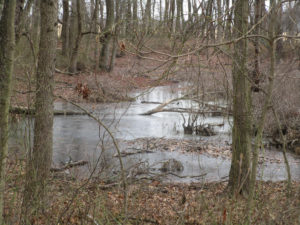
vernal pond at Pigeon Swamp in South Brunswick, Middlesex County.
ATLANTIC OCEAN TEMPERATURES: The Atlantic Ocean temperature along the New Jersey coast was running at about 35 to 37 degrees over the February 10-11 weekend.
SUNRISE/SUNSET: From Sunday, February 11, to Saturday, February 17, the sun will rise about 6:45 to 6:55 a.m. and set at about 5:30 to 5:35 p.m. From Sunday, February 18, to Saturday, February 24, the sun will rise about 6:40 to 6:45 a.m. and set 5:35 to 5:45 p.m.
WEATHER: The National Weather Service forecasting office serving the Jersey Midlands is at http://www.weather.gov/phi/.
UPCOMING:
March 3, Saturday, 10 a.m. to 1:30 p.m., Somerset County — Deer Management Symposium at the Elks Lodge, 354 Route 518, Montgomery, free. Different stakeholders are to discuss deer management. More information is available at info@sourland.org.
March 10, Saturday, 11 a.m. to 12:30 p.m., Ocean County — Science Saturday, talk on striped bass management and fishing by Brendan Harrison, a New Jersey Division of Fish and Wildlife fishing technician,at the Long Beach Island Foundation of Arts and Sciences, 120 Long Beach Boulevard, Loveladies, 08008, $5 for non-members. More information at telephone 609-494-1241.
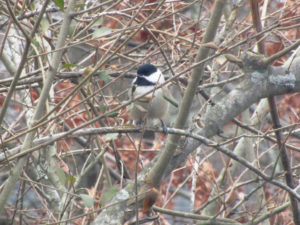
The Carolina chickadee in front of my living room window.
— Joseph Sapia
2018, February 11, Sunday,
In the Pine Barrens around Helmetta, Middlesex County,
Joe Sapia, 61, is a lifelong resident of Monroe — in South Middlesex County, where his maternal family settled more than 100 years ago. He is a Pine Barrens naturalist and an organic gardener of vegetables and fruit, along with zinnias and roses.
He draws inspiration on the Pine Barrens around Helmetta from his mother, Sophie Onda Sapia, who lived her whole life in these Pines, and his Polish-immigrant grandmother, Annie Poznanski Onda.
He gardens the same backyard plot as did his Grandma Annie and Italian-American father, Joe Sr. Both are inspirations for his food gardening. Ma inspires his rose gardening.
Joe is a semi-retired print journalist of almost 40 years. His work also is at @JosephSapia on Twitter.com, along with Facebook.com on the Jersey Midlands page.
Copyright 2018 by Joseph Sapia
Except as noted, article and photos by Joe Sapia
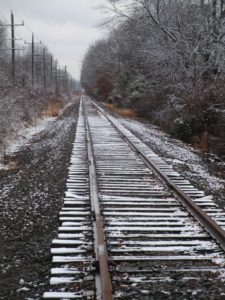
On the ConRail railroad tracks between Prospect Plains and Cranbury Station on the boundary of Cranbury and Monroe, Middlesex County.
JEEP-LESS, THE BAD: My Jeep Wrangler has been in the shop. A metal plate in the clutch area cracked. When mechanic-friend Frank Ulatowski told me the parts distributor said, I never ordered this part before, I knew this could be trouble. The part, being shipped from Detroit, finally did come in and Frank installed it, but the repair was set back by the need for a second part. The Jeep should be ready Monday. For the past week, though, my travels have been limited – generally confined to walking in my hometown of Monroe and the bordering towns of Helmetta, Spotswood, South Brunswick, Cranbury, and Jamesburg.
JEEP-LESS, THE GOOD: With no work scheduled, I decided to not rent a motor vehicle, instead hoofing it. I have thought about this for years – on my days not working, try to only walk or bicycle. So, I have been constantly walking, along with some bicycling. My longest walk was 11 miles – a trek home from the doctor’s office for a followup on my annual exam in Monroe (to which I taxied), with a detour to Teddy’s luncheonette in Cranbury and, later, supper in Helmetta. Aside from the health benefits of walking, it has taken me on routes less-traveled and slowed me to observe better. So, I have a lot of cool observations to pass along.
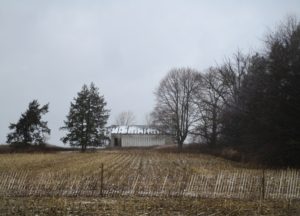
An old farm site in Cranbury.
SNOWFALL UPDATE: The two snowfalls on Tuesday, January 30, amounted to an estimated 1.0 inch of snowfall at my Monroe house. This brings the seasonal total to 18.0 inches. The normal season average is about 25.8 inches, recorded in New Brunswick, about 7-1/2 miles away; We still have about 2-1/2 months of snow potential to reach the average.

The view I awoke to, as seen from my bedroom window, on Tuesday, January 30, in Monroe.
‘POWDERED SUGAR’ SNOW: When I awoke Tuesday, January 30, I found a snowfall that looked as though the vegetation was covered with powdered sugar. It was a beautiful find to start the day!
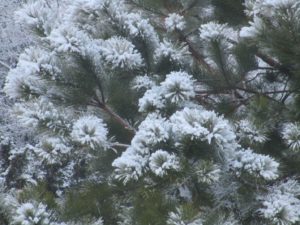
The “powdered sugar” snow on the pitch pine, “Pinus rigida,” in my backyard in Monroe.
NORTHERN HARRIERS, CONTINUED: I continue to see northern harriers, “Circus cyaneus,” more than I have ever seen. This week, I saw one at Helmetta Pond, Middlesesex County – the first time I recall seeing one there. Remember, as a nester, New Jersey lists them as “endangered,” or in imminent peril. Look for them hunting game by flying low above fields or marshes. They are sleek and have a white rump patch – females are brown, males are gray-white. As Roger Dreyling, birder extraordinaire from Monroe, noted, “I like harriers, especially males, which are sometimes called ‘gray ghosts.’”
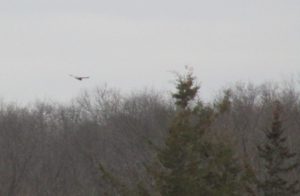
A female northern harrier at Helmetta Pond. Notice the white rump patch.
UPPER MILLSTONE RIVER EAGLES NEST: Anne Price and I, volunteers for the state Department of Environmental Protection, have been watching this nest. We agree it appears the eagles are incubating an egg or eggs. For example, I saw an eagle fly by the nest and perched nearby, while it appeared the other one was in the nest. Because bald eagles are a jeopardized species in New Jersey – “endangered,” or under imminent threat as a nester, and “threatened,” or could become “endangered” if conditions persist, in general – we are being discreet in identifying the location of the nest. (In the 2017 state eagles report, http://www.state.nj.us/dep/fgw/ensp/pdf/eglrpt17.pdf, this nest is listed as No. 184, “Upper Millstone.”)
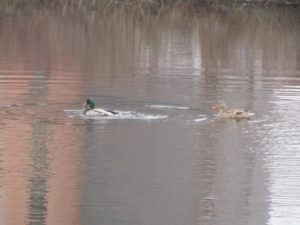
Mallard ducks, “Anas platyrhynchos,” at a fire-suppression pond at the former George W. Helme Snuff Mill in Helmetta. The more colorful male is on the left.
VOICES FROM AFIELD, EAGLE SIGHTINGS: I keep saying, if you want to see bald eagles, look up into the sky. Various reports came in during the week week. Michele Arminio of Monroe reported seeing a flying eagle at Milltown Road, between Route 18 and Ryders Lane, in East Brunswick. Janice Weinman reported seeing one at the South River and its wetlands on the boundary of Old Bridge, Sayreville, and East Brunswick: “Flying out of the marshlands area on the east side of Bordentown Avenue, flying towards east Brunswick. It was an adult as it had its white head, but not too big. I was surprised to see one there. I was not aware of any in that area.” Actually, this one could be nesting in the Old Bridge area. A pair, there, has repeatedly moved its nest and, last year, a nest could not be located. Paul Reed reported an eagle at Helmetta Pond. Roger Dreyling of Monroe reported an immature eagle at “Jamesburg Lake” (Lake Manalapan) in Monroe. Duke Farms in Hillsborough, Somerset County, has a camera on its eagle nest, http://dukefarms.org/making-an-impact/eagle-cam/.
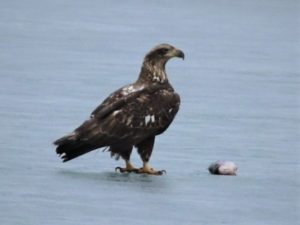
An immature bald eagle – notice the lack of white head and tail – with a fish at “Jamesburg Lake” (Lake Manalapan) in Monroe in January. (Photograph copyright 2018 by Roger Dreyling)
MUTE SWANS: Ugh, I dislike mute swans, “Cygnus olor,” non-natives that hurt local ecosystems through their aggressive eating of aquatic vegetation and scaring off native species. But they are naturalized here…. This week, I saw a pair at Helmetta Pond.
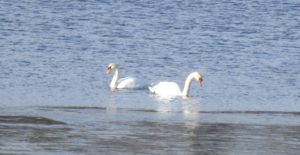
Mute swans on Helmetta Pond.
BACKYARD SHRUB PILE: I keep a pesticide- and fertilizer-free yard. It is only a quarter-acre, or about 10,000 square feet. But it is productive — a vegetable and fruit garden of more than 1,000 square feet, bird-feeders, bird baths. Roughly only 10 percent of rainwater drains off the property. One of the pro-environment bits of my property is the brush pile and tall-grass patch I keep in the backyard. The brush pile, for example, is a place for birds to retreat to and perch. This week, I photographed a few house sparrows, “Passer domesticus,” is the pile. (I was happy to see the brush pile being used, despite being used by house sparrows, a non-native species.)
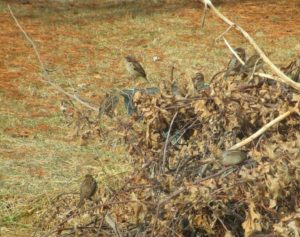
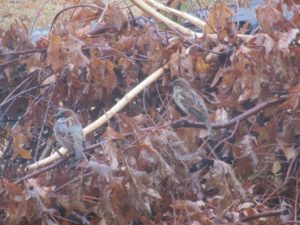
House sparrows in the backyard bush pile.
OTHER YARD BIRDS: I took random photos of various bird species in my yard: cardinal, “Cardinalis cardinalis”; dark-eyed juncos, “Junco hyemalis,” or “snowbirds”; red-bellied woodpecker, “Melanerpes carolinus”; and grackles, “Quiscalus quiscula.”
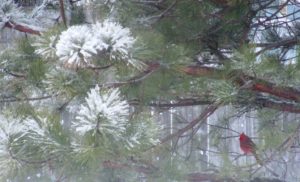
A cardinal, “Cardinalis cardinalis,” in the backyard pitch pine.
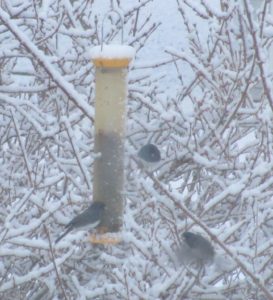
Snowbirds – one at the niger feeder, one perched nearby, one flying in.

Red-bellied woodpecker at the sunflower kernel feeder.
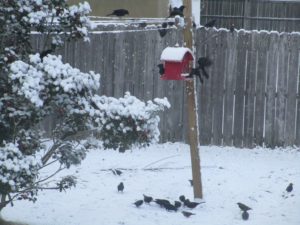
Grackles at the feeder.
VOICES FROM AFIELD, ROBINS: “Polish Paul” Migut, a friend going back to childhood, checked in on robins, “Turdus migratorius.” He, too, had them in his South River yard. “Thursday (February 1) morning, looking into my rear yard, spotted about 10 to 12 robins,” Paul said. “Looked very healthy, plump.” Again, some may consider a robin as a sign of spring, but they are year-around.
RED-TAILED HAWKS: This week, I was able to get some pretty close-up photographs of red-tailed hawks, “Buteo jamaicensis.” Looked for them perched, soaring with a creamy underbelly look and rust-colored tail, or a big bird flying and flapping its wings about a half-dozen times.
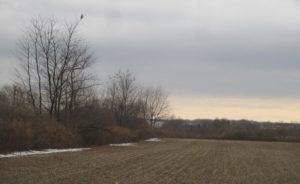
A red-tailed hawk perches in a tree and watches over farmland in South Brunswick.
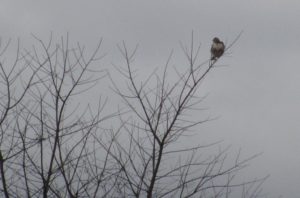
A closeup of the South Brunswick red-tailed hawk.
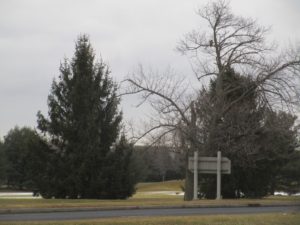
A red-tailed hawk perches in a tree near New Jersey Turnpike Exit 8-A in Monroe.
DEAD GREAT BLUE HERON: I was hiking in the Pine Barrens around Helmetta and at Cranberry Bog came across a dead blue heron, “Ardea Herodias.” It was lying on dry ground, inches from the water. Its eyes were in place and its body supple, so it probably was not dead all that long. I saw no obvious cause of death. Its anal area was ripped up a bit, but that likely was caused by a scavenger after death. I talked to Rick Lear, head of the Middlesex County Office of Parks and Recreation, about it and he speculated it died of starvation, because of the difficulty of finding food, such as aquatic animals and small mammals, this time of year.
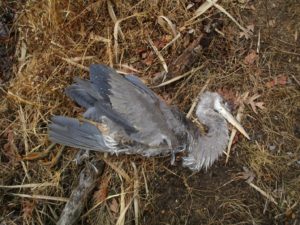
A great blue heron I found dead at Cranberry Bog in Monroe.
FARMLAND, DEVELOPABLE LAND: I recall saying, “Potatoes like dry feet and so do developers.” Well, look at this gravelly, or well-drained, farmland in South Brunswick. Nice developable land, unfortunately! Even more unfortunate is it being located on the New Jersey Turnpike, near an exit, 8-A.
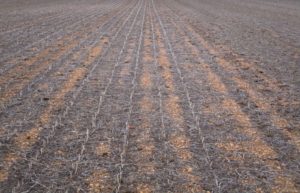
Gravelly farmland in South Brunswick.
PHRAGMITES: I am noticing a lot of invasive reed grass, genus “Phragmites.” This stuff really clogs wetlands and is difficult to control. It is not only bad for the environment, but also for drainage. Beware in heavy rain, this will contribute to flooding. And phragmites invasion is only getting worse, from what I see.
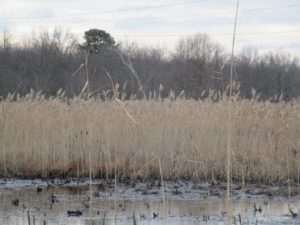
Phragmites clogging Cranberry Bog in Monroe.
BARKING FOX: One night, I stood in my yard and listened to this yip, yip, yip call from the woods or near the woods. It was a red fox, “Vulpes vulpes.” So, do not only look, but listen. Nature is all around us.
NON-POINT SOURCE POLLUTION: I was walking in the Manalapan Brook floodplain in Helmetta and there it was, non-point source pollution – garbage — that got into the water system and floated about. Ever seen those notices about garbage getting into storm drains? They really mean it. Throw a plastic bottle out of a car miles inland and, at least in theory, it could wind up in the ocean. Even if it does not wind up in the ocean, it could wind up in the freshwater system. And even if it does not do that, it is still litter.
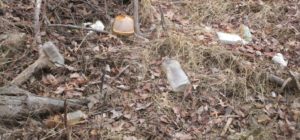
Non-point source pollution in the Manalapan Brook floodplain at Helmetta.
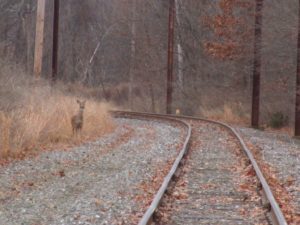
ATLANTIC OCEAN TEMPERATURES: The Atlantic Ocean temperature along the New Jersey coast was running at about 35 to 37 degrees on the February 3-4 weekend.
SUNRISE/SUNSET: From Sunday, February 4, to Saturday, February 10, the sun will rise about 7 a.m. and set 5:25 p.m. From Sunday, February 11, to Saturday, February 17, the sun will rise about 6:45 to 6:55 a.m. and set at about 5:30 to 5:35 p.m.
WEATHER: The National Weather Service forecasting office serving the Jersey Midlands is at http://www.weather.gov/phi/.
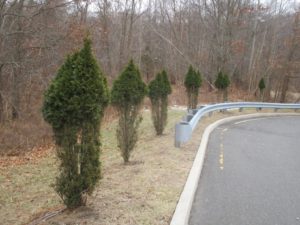
Deer damage to arbor vitae trees at the old George W. Helme Snuff Mill power plant in the Helmetta.
Joe Sapia, 61, is a lifelong resident of Monroe — in South Middlesex County, where his maternal family settled more than 100 years ago. He is a Pine Barrens naturalist and an organic gardener of vegetables and fruit, along with zinnias and roses. He draws inspiration on the Pine Barrens around Helmetta from his mother, Sophie Onda Sapia, who lived her whole life in these Pines, and his Polish-immigrant grandmother, Annie Poznanski Onda. He gardens the same backyard plot as did his Grandma Annie and Italian-American father, Joe Sr. Both are inspirations for his food gardening. Ma inspires his rose gardening. Joe is a semi-retired print journalist of almost 40 years. His work also is at @JosephSapia on Twitter.com, along with Facebook.com on the Jersey Midlands page.
Copyright 2018 by Joseph Sapia
Except where noted, article and photos by Joe Sapia
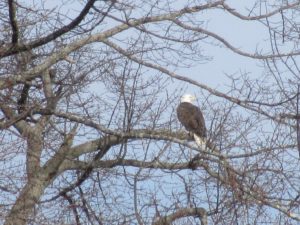
A bald eagle perched in a tree near its “Upper Millstone River” nest on the boundary of Middlesex and Mercer counties.
UPPER MILLSTONE RIVER EAGLE NEST: As the state Department of Environmental Protection monitors of the nest, Anne Price and I have been watching the pair of bald eagles, “Haliaeetus leucocephalus.” By week’s end, they were still in pre-nesting mode – flying in courtship, perched near each other near the nest, perched together on the nest. Stay tuned, there should be an egg or eggs during the week of January 28. Because bald eagles are a jeopardized species in New Jersey – “endangered,” or under imminent threat as a nester, and “threatened,” or could become “endangered” if conditions persist, in general – we are being discreet in identifying the location of the nest. (In the 2017 state eagles report, http://www.state.nj.us/dep/fgw/ensp/pdf/eglrpt17.pdf, this nest is listed as No. 184, “Upper Millstone.”)
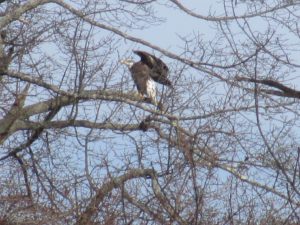
The eagle, spreading its wings, on a tree near the nest.
NORTHERN HARRIERS: I love northern harriers, “Circus cyaneus,” flying low above fields, searching for mammals to eat. They glide eloquently, putting on quite a show. This week, I was watching them on the Monroe-Cranbury boundary, Middlesex County – one at the wetlands mitigation bank at Cranbury Station, then around the wetlands mitigation bank at Wyckoff’s Mills. I did not get a good look at the Cranbury Station “marsh hawk,” but watched the Wyckoff’s Mills one for several minutes, flying back and forth, seemingly unbothered by me. The glimpse I got of the Cranbury Station harrier suggested it was a male, because it looked to be light-colored. The Wyckoff’s Mills harrier was a female – brown in color. Harriers, whether male or female, are easy to identify – flying within feet of the ground, sleek-bodied, having a white rump patch.
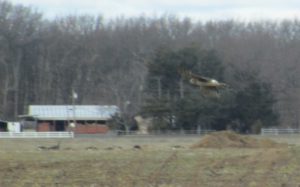
A northern harrier flies across farmland in at Wyckoff’s Mills on the Cranbury, Middlesex County, side of the road. Brown in color means it is a female. Notice the white rump patch females and males both have.

The female northern harrier flies above the wetlands mitigation bank on the Monroe side of the road at Wyckoff’s Mills, Middlesex County.

The female northern harrier flies on the Monroe side of the road at Wyckoff’s Mills, Middlesex County.
BLACK SQUIRRELS: If you want to see black squirrels, check out Princeton or Cranbury. Several years ago, I heard a story, although I do not know if it is true, that someone from Cranbury went to Princeton, trapped some black squirrels, and brought them to Cranbury. Actually, black squirrels are just a black phase of a gray squirrel, “Sciurus carolinensis.” Gray squirrels have no gray hairs — only white, black, and brown with the combination giving them a varied appearance.
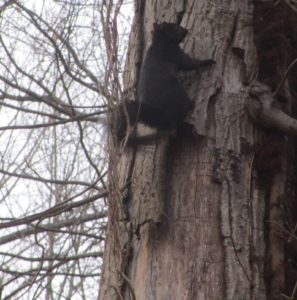
A black-phase gray squirrel in the woods between Wyckoff’s Mills and Cranbury Station in Cranbury, Middlesex County.
DEER IN THE DAYTIME: Twice in one day, I saw deer, “Odocoileus virginianus,” seemingly unbothered in the daytime in areas with a lot of human traffic. At noon, I saw one in a residential area on Riva Avenue, East Brunswick, Middlesex County. Then, 3-1/2 hours later, one was in a lawn area of Thompson Park, Monroe, Middlesex County. I thought this daytime lack of fear of these deer was brazen.
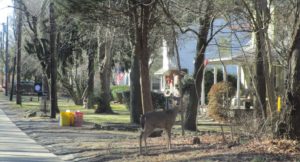
The deer on Riva Avenue in East Brunswick, Middlesex County.
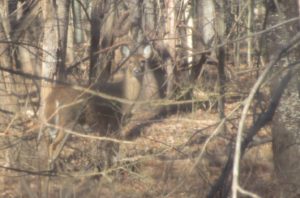
The East Brunswick deer fled me, then checked me out from the relative safety of the woods.
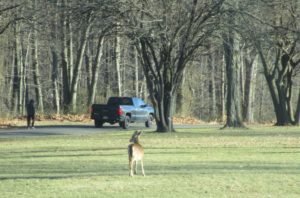
A deer in Thompson Park in Monroe, Middlesex County
ROBINS, A SIGN OF SPRING?: Some may think of robins, “Turdus migratorius,” are a sign of spring. But, actually, they are around in the winter. Perhaps more in the woods this time of year because of berries as a food source. Then, as it warms, with insects and worms becoming available, in our yards where we readily see them. But a little group of robins popped into my yard, across from woods, this week. (I have this affection for robins, because, I think, it was the first bird I learned to identify as a child.)
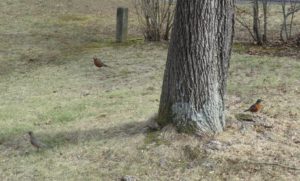
Robins in my front yard in Monroe, Middlesex County.
BIRDS, STARLINGS: Recently, I have noticed flocks of starlings, “Sturnus vulgaris.” The photograph shows them on farmland in Monroe, Middlesex County. (They are non-native, brought from Europe to North America in the 1800s and, now, naturalized here.)
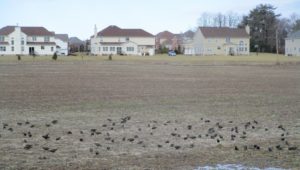
A flock of starlings on farmland in Monroe, Middlesex County.
YARD BIRDS: I was able crank off photographs of a white-throated sparrow, “Zonotrichia albicollis,” in one of my favorite bird-watching areas – through my living room window in Monroe, Middlesex County.
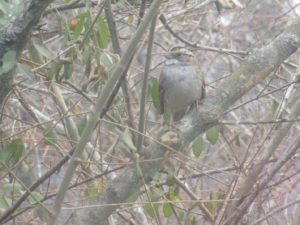
A white-throated sparrow in my front yard in Monroe, Middlesex County.
STINK BUGS: With the cold weather, I have an occasional brown marmorated stink bug, “Halyomorpha halys,” invading my house. I exterminate them. Their stink is not bad – more an earthy organic smell than a nauseating one. But they are highly invasive non-natives that could be devasting to farming. They have been documented for only about 20 years, believed to have arrived from East Asia to the Allentown, Pennsylvania, area via cargo. See https://njaes.rutgers.edu/stinkbug/.
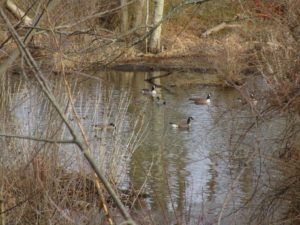
Canada geese, “Branta canadensis,” and mallard ducks, “Anas platyrhynchos,” along the Millstone River in East Windsor, Mercer County.
JERSEY MIDLANDS PRECARIOUS LOCATION: The beautiful Jersey Midlands are situated precariously between two major metropolitan areas, New York City and Philadelphia, and in the heart of the Boston-to-Richmond megalopolis. So, we are under development pressure. But, sometime, when we see our natural world beauty, we may forget how close we are. Reminders are the ongoing development (and destruction of the Midlands); traffic on the New Jersey Turnpike, Garden State Parkway and elsewhere; jets passing overhead.
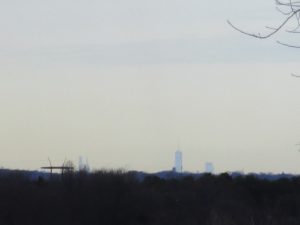
A view of the New York City skyline – the Freedom Tower, center, and the Empire State Building, just to the right of the utility line tower – through the eye of a point-and-shoot camera about 35 miles away from Redmond’s Hill at Thompson Park in Monroe, Middlesex County.
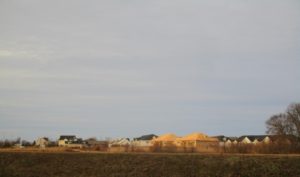
Here is an example of that development – in what I grew up calling “The Farms” of Monroe, Middlesex County.
PEGGY RENNER, ARCHERY CHAMP: I stumbled upon an obituary for Peggy Renner, who died this week. She and her family ran an archery-outdoors store in the Jamesburg-Monroe area for years. A salute to Peggy. Peggy’s obituary, http://www.legacy.com/obituaries/mycentraljersey/obituary.aspx?n=margaret-w-renner&pid=188001769&fhid=27060.
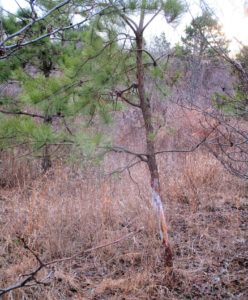
A deer rub of a male deer, “Odocoileus virginianus.” Bucks will rub the velvet off their antlers because they are hormonal and ready to mate, along with declaring their mating turfs. This is a pretty big rub, so there must be a pretty big buck around the Wyckoff Mills wetlands bank on the Monroe-Cranbury boundary, Middlesex County.
SWEET GUM TREE: Seeds from the pods of sweet gum, “Liquidambar styraciflua,” are a food for wildlife. This Internet site shows artsy uses for the seed pods, https://www.pinterest.com/beckyblue65/sweetgum-tree-seed-pods/.
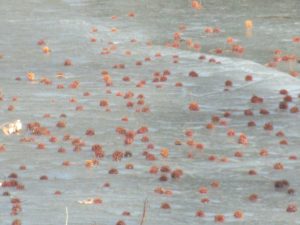
Seed pods of the sweet gum tree dot the ice of Devil’s Brook on the boundary of Plainsboro and South Brunswick, Middlesex County.
TURKEY VULTURES: We may note turkey vultures, “Cathartes aura,” flying V-winged or eating roadkill. They are a common bird. This week, I caught two interesting photos, one of them on a roadkill, the other in silhouette illustrating their look.
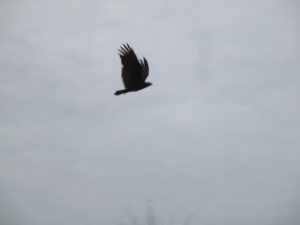
A turkey vulture. From Cornell University’s All About Birds website, “…They have long ‘fingers’ at their wingtips and long tails that extend past their toe tips in flight” — both evident in the photograph.
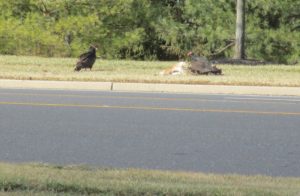
Turkey vultures on a deer carcass on Route 535 in Cranbury, Middlesex County.
SKY VIEWS: This week’s sky photographs are from Middlesex County – Cranbury and Monroe.

A farmland scene between Applegarth and Wyckoff’s Mills in Monroe, Middlesex County.
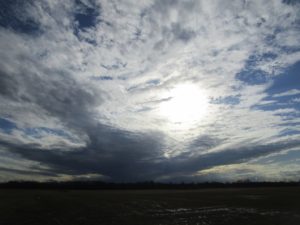
Again, a farmland scene between Applegarth and Wyckoff’s Mills in Monroe, Middlesex County.
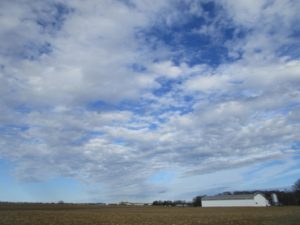
And, again, a farmland scene between Applegarth and Wyckoff’s Mills in Monroe, Middlesex County.

Wyckoff’s Mills farmland in Cranbury, Middlesex County.

Looking toward Applegarth in Monroe, Middlesex County.

At the Dey Farm historic site in Monroe, Middlesex County.
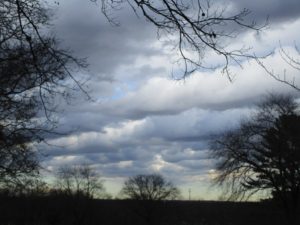
At Thompson Park in Monroe, Middlesex County.

At Saint James Cemetery in Monroe, Middlesex County.

Farmland in Cranbury, Middlesex County.
ATLANTIC OCEAN TEMPERATURES: The Atlantic Ocean temperature along the New Jersey coast is running at about 35 or 36 degrees.
WEATHER: The National Weather Service forecasting office serving the Jersey Midlands is at http://www.weather.gov/phi/.
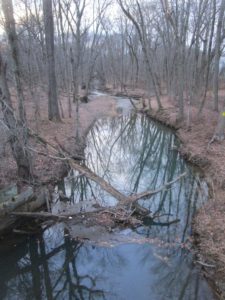
Cranbury Brook, here at Cranbury, Middlesex County, is part of the Raritan River watershed. Cranbury Brook runs from the Route 33 area at Millstone and Manalapan in Monmouth County.
SUNRISE/SUNSET: For Sunday, January 28, to Saturday, February 3, the sun will rise about 7:05 a.m. to 7:10 a.m. and set about 5:10 p.m. to 5:20 p.m.
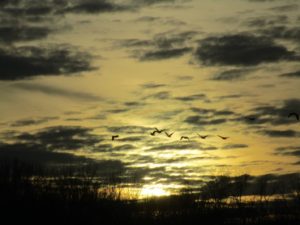
Canada geese flying at sunset on the border of Cranbury and Monroe, Middlesex County.
Joe Sapia, 61, is a lifelong resident of Monroe — in South Middlesex County, where his maternal family settled more than 100 years ago. He is a Pine Barrens naturalist and an organic gardener of vegetables and fruit, along with zinnias and roses. He draws inspiration on the Pine Barrens around Helmetta from his mother, Sophie Onda Sapia, who lived her whole life in these Pines, and his Polish-immigrant grandmother, Annie Poznanski Onda. He gardens the same backyard plot as did his Grandma Annie and Italian-American father, Joe Sr. Both are inspirations for his food gardening. Ma inspires his rose gardening. Joe is a semi-retired print journalist of almost 40 years. His work also is at @JosephSapia on Twitter.com, along with Facebook.com on the Jersey Midlands page.
Copyright 2018 by Joseph Sapia

























































































